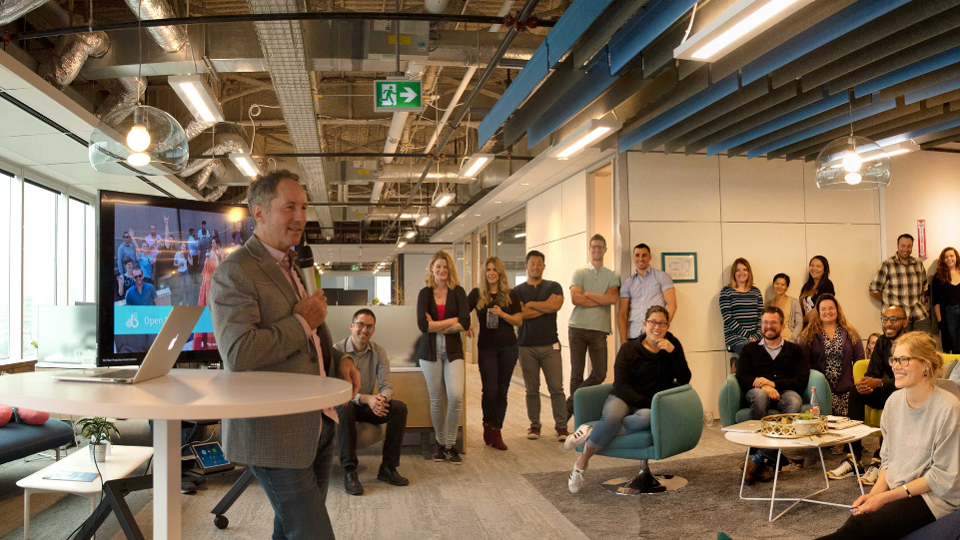
How do you respond when asked you what you do for a living? When his young daughter asked him this question, recovering lawyer, Bryan de Lottinville, answered, “I fix up companies and sell them for as much as I can, honey.”
Suddenly he grasped he was not creating the professional legacy he desired. “I had always thought I would leave the world a little better than I found it,” de Lottinville says. At this moment, he realized his intentions and his behaviors were not in synch.
How did de Lottinville act on his aha experience? He pursued his dream of founding a business that could be a catalyst for infusing good into the world.
While this might seem like a pipedream to some, de Lottinville transformed his vision into a real company. In 2008, he founded Benevity, now the global leader in corporate social responsibility and employee engagement software.
His goal for Benevity was to revolutionize corporate philanthropy. By applying his skills for “constructive disruption,” he is moving corporate charitable giving from a fund-raising and hand-out mentality to one that taps into people’s sense of yearning for purpose, meaning, and impact in their lives.
How did he do it?
Bryan describes how he molded his business into the wildly successful company it is today. His secret sauce? He built a unique and sustainable organizational culture from the start.
De Lottinville describes the power of a unique company culture to drive success. “You have to view culture as a strategic lever and invest in it thoughtfully and intentionally,” he claims.
He asserts that every company and each leader must build a culture on a compelling vision and values that are more than mere words. Within the Benevity culture, the vision and values show up in a thousand little ways, such as how they hire, promote, and fire.
For example, Benevity has a BUF (Benevity Unicorn Factor) score that they use when recruiting. It consists of 10 or 12 attributes that they believe are critical to success in their environment. While some are pragmatic, such as gray matter, others are a function of who they are and what’s essential such as authenticity, adaptability, and humility.
Who is responsible for the culture?
Everyone in the company understands the responsibility of building and maintaining this unique culture that underlies Benevity’s success.
De Lottinville uses the analogy of building a house. Some design the house while others create it. All who live in it maintain it, and from time to time, a few renovate it.
In the early days, creating the culture to support the vision was easy.
Benevity had a handful of leaders who consistently exhibited values-based behaviors. However, the challenge is maintaining this positive and unique culture as the company grows.
De Lottinville describes himself as the chief proponent and protector of the culture because he views it as a strategic business lever. He says that companies must invest in it, just like any other asset.
How is the dream faring today?
You may be wondering how de Lottinville’s dream is working out. The numbers tell the story.
Currently, Benevity’s software is available in 17 languages. Over 600 companies, and their network of 12 million employees, have used it to make over 4 billion dollars in donations, complete 100,000 positive actions and log 23 million hours of volunteering time to over 230,000 charities worldwide.
Their clients include iconic companies like Microsoft, Apple, Visa, and Paypal, to name only a few.
And wait – there is more.
Benevity is not only a dream made real but a company with breakneck growth. The company has approximately 600 employees. And they expect to add 200 full-time positions over this next year.
What do you want for your professional legacy?
If you want to create a stronger social impact through your work, heed de Lottinvilles’ advice.
First, establish a resonant, relatable and aspirational vision—whether for the entire company or for your role in it. Ideally, your vision will engage people by connecting with their innate desire for purpose, meaning, and impact.
Second, allow the vision to shape the culture. Your systems and behaviors must align.
And third, never take culture for granted. Attend to it as the critical asset that it is.
No matter what your role, whether you head up an entire enterprise or lead from within the company, you can enhance your social impact through your work. Focus on culture as the secret sauce. Align it with an aspirational vision and nurture it as your most valuable asset.
Question? Comment?
Or just want to learn more about developing a Sustainable Culture?
